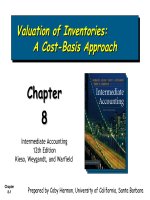Intermediate accounting 15e kieso warfield chapter 08
Bạn đang xem bản rút gọn của tài liệu. Xem và tải ngay bản đầy đủ của tài liệu tại đây (1.97 MB, 68 trang )
INTERMEDIATE
Intermediate
ACCOUNTING
Intermediate
Accounting
Accounting
F I F T E E N T H
8-1
E D I T I O N
Prepared by
Coby Harmon
Prepared by
University of California,
BarbaraPrepared by
CobySanta
Harmon
Harmon
Westmont
College SantaCoby
University
of California,
Barbara
University of California, Santa Barbara
Westmont College
kieso
weygandt
warfield
team for success
PREVIEW OF CHAPTER
8
Intermediate Accounting
15th Edition
Kieso Weygandt Warfield
8-2
8
Valuation of Inventories:
A Cost-Basis Approach
LEARNING OBJECTIVES
After studying this chapter, you should be able to:
1.
Identify major classifications of inventory.
6.
2.
Distinguish between perpetual and
periodic inventory systems.
Explain the significance and use of a
LIFO reserve.
7.
Understand the effect of LIFO
liquidations.
8.
Explain the dollar-value LIFO method.
9.
Identify the major advantages and
disadvantages of LIFO.
3.
4.
5.
8-3
Determine the goods included in
inventory and the effects of inventory
errors on the financial statements.
Understand the items to include as
inventory cost.
Describe and compare the cost flow
assumptions used to account for
inventories.
10. Understand why companies select given
inventory methods.
Inventory Issues
Classification
Inventories are asset:
items held for sale in the ordinary course of business, or
goods to be used in the production of goods to be sold.
Businesses with Inventory
Merchandiser
8-4
or
Manufacturer
LO 1 Identify major classifications of inventory.
Inventory Issues
Classification
8-5
One inventory
account.
Purchase
merchandise in
a form ready for
sale.
Illustration 8-1
LO 1 Identify major classifications of inventory.
Inventory Issues
Classification
Illustration 8-1
Three accounts
Raw
Materials
Work
in Process
Finished
8-6
Goods
LO 1 Identify major classifications of inventory.
Inventory Issues
Illustration 8-2
Classification
8-7
LO 1
8
Valuation of Inventories:
A Cost-Basis Approach
LEARNING OBJECTIVES
After studying this chapter, you should be able to:
1.
Identify major classifications of inventory.
6.
2.
Distinguish between perpetual and
periodic inventory systems.
Explain the significance and use of a
LIFO reserve.
7.
Understand the effect of LIFO
liquidations.
8.
Explain the dollar-value LIFO method.
9.
Identify the major advantages and
disadvantages of LIFO.
3.
4.
5.
8-8
Determine the goods included in
inventory and the effects of inventory
errors on the financial statements.
Understand the items to include as
inventory cost.
Describe and compare the cost flow
assumptions used to account for
inventories.
10. Understand why companies select given
inventory methods.
Inventory Issues
Inventory Cost Flow
Illustration 8-3
Two types of systems for maintaining inventory records — perpetual
system or periodic system.
8-9
LO 2 Distinguish between perpetual and periodic inventory systems.
Inventory Cost Flow
Perpetual System
1. Purchases of merchandise are debited to Inventory.
2. Freight-in is debited to Inventory. Purchase returns and
allowances and purchase discounts are credited to
Inventory.
3. Cost of goods sold is debited and Inventory is credited for
each sale.
4. Subsidiary records show quantity and cost of each type of
inventory on hand.
The perpetual inventory system provides a continuous
record of Inventory and Cost of Goods Sold.
8-10
LO 2 Distinguish between perpetual and periodic inventory systems.
Inventory Cost Flow
Periodic System
1. Purchases of merchandise are debited to Purchases.
2. Ending Inventory determined by physical count.
3. Calculation of Cost of Goods Sold:
Beginning inventory
$ 100,000
Purchases, net
+ 800,000
Goods available for sale
8-11
LO 2 Distinguish between perpetual and periodic inventory systems.
Inventory Cost Flow
Comparing Perpetual and Periodic System
Illustration: Fesmire Company had the following transactions
during the current year.
Record these transactions using the Perpetual and Periodic
systems.
8-12
LO 2 Distinguish between perpetual and periodic inventory systems.
Inventory Cost Flow
8-13
Illustration 8-4
Advance slide in presentation mode to reveal answer.
LO 2
Inventory Cost Flow
Illustration: Assume that at the end of the reporting period, the
perpetual inventory account reported an inventory balance of
$4,000. However, a physical count indicates inventory of $3,800
is actually on hand. The entry to record the necessary write-down
is as follows.
Inventory Over and Short
200
Inventory
200
Note: Inventory Over and Short adjusts Cost of Goods Sold. In practice, companies
sometimes report Inventory Over and Short in the “Other revenues and gains” or
“Other expenses and losses” section of the income statement.
8-14
LO 2 Distinguish between perpetual and periodic inventory systems.
Inventory Issues
Inventory Control
All companies need periodic verification of the inventory records
by
actual count, weight, or measurement,
with
counts compared with detailed inventory records.
Companies should take the physical inventory
near
the end of their fiscal year,
to
properly report inventory quantities in their annual accounting
reports.
8-15
LO 2 Distinguish between perpetual and periodic inventory systems.
STAYING LEAN
WHAT’S
YOUR PRINCIPLE
Wal-Mart Stores, Inc. uses its buying
power in the supply chain to purchase an
increasing proportion of its goods directly
from manufacturers and on a combined
basis across geographic borders. Wal-Mart
estimates that it saves 5–15% across its
supply chain by implementing direct
purchasing on a combined basis for the 15
countries in which it operates. Thus, WalMart has a good handle on what products
its needs to stock, and it gets the best
prices when it purchases.
Wal-Mart also provides a classic example
of the use of tight inventory controls.
Department managers use a scanner that
when placed over the bar code
corresponding to a
8-16
particular item, will tell them how many of
the items the store sold yesterday, last
week, and over the same period last year.
It will tell them how many of those items are
in stock, how many are on the way, and
how many the neighboring Walmart stores
are carrying (in case one store runs out).
Wal-Mart’s inventory management
practices have helped it become one of the
top-ranked companies on the Fortune 500
in terms of sales.
Source: J. Birchall, “Walmart Aims to Cut
Supply Chain Cost,” Financial Times (January
4, 2010).
LO 2 Distinguish between perpetual and periodic inventory systems.
Basic Issues in Inventory Valuation
Companies must allocate the cost of all the goods available for
sale (or use) between the goods that were sold or used and
those that are still on hand.
Illustration 8-5
8-17
LO 2 Distinguish between perpetual and periodic inventory systems.
Basic Issues in Inventory Valuation
Valuation requires determining
8-18
The physical goods (goods on hand, goods in transit,
consigned goods, special sales agreements).
The costs to include (product vs. period costs).
The cost flow assumption (specific Identification,
average cost, FIFO, LIFO, retail, etc.).
LO 2 Distinguish between perpetual and periodic inventory systems.
8
Valuation of Inventories:
A Cost-Basis Approach
LEARNING OBJECTIVES
After studying this chapter, you should be able to:
1.
Identify major classifications of inventory.
6.
2.
Distinguish between perpetual and
periodic inventory systems.
Explain the significance and use of a
LIFO reserve.
7.
Understand the effect of LIFO
liquidations.
8.
Explain the dollar-value LIFO method.
9.
Identify the major advantages and
disadvantages of LIFO.
3.
4.
5.
8-19
Determine the goods included in
inventory and the effects of inventory
errors on the financial statements.
Understand the items to include as
inventory cost.
Describe and compare the cost flow
assumptions used to account for
inventories.
10. Understand why companies select given
inventory methods.
Physical Goods Included in Inventory
A company should record purchases when it obtains legal
title to the goods.
Illustration 8-6
8-20
LO 3 Determine the goods included in inventory and the effects
of inventory errors on the financial statements.
NO PARKING!
WHAT’S
YOUR PRINCIPLE
In one of the more elaborate accounting frauds,
employees at Kurzweil Applied Intelligence Inc.
booked millions of dollars in phony inventory
sales during a two-year period that straddled two
audits and an initial public stock offering. They
dummied up phony shipping documents and
logbooks to support bogus sales transactions.
Then they shipped high-tech equipment, not to
customers, but to a public warehouse for
“temporary” storage, where some of it sat for 17
months. (Kurzweil still had ownership.)
To foil auditors’ attempts to verify the existence of
the inventory, Kurzweil employees moved the
goods from warehouse to warehouse. To cover
the fraudulently recorded sales transactions as
auditors closed in, the employees brought back
the still-hidden goods, under the pretense that
the goods were returned by customers. When
auditors uncovered the fraud, the bottom dropped
out of Kurzweil’s stock.
8-21
Similar inventory shenanigans occurred at
Delphi, which used side-deals with third parties to
get inventory off its books and to record sales.
The overstatement in income eventually led to a
bankruptcy fi ling for Delphi.
More recently and with an international twist,
concerns about inventory shenanigans are
surfacing in China. Following years of torrid
growth, the global economic slowdown has
resulted in a huge buildup of unsold goods that is
cluttering shop floors, clogging car dealerships,
and filling factory warehouses. The large
inventory overhang is raising alarms about
phantom profits and suspect economic data
coming out of China.
Source: Adapted from “Anatomy of a Fraud,”
BusinessWeek (September 16, 1996), pp. 90–94; J.
McCracken, “Delphi Executives Named in Suit over
Inventory Practices,” Wall Street Journal (May 5, 2005), p.
A3; and K. Bradsher, “China Confronts Mounting Piles of
Unsold Goods,” New York Times (August 23, 2012).
LO 3
Physical Goods Included in Inventory
Effect of Inventory Errors
Ending
Inventory
Misstated
Illustration 8-7
The effect of an error on net income in one year will be counterbalanced in the next,
however the income statement will be misstated for both years.
8-22
LO 3 Determine the goods included in inventory and the effects
of inventory errors on the financial statements.
Effect of Inventory Errors
Illustration: Jay Weiseman Corp. understates its ending inventory
by $10,000 in 2013; all other items are correctly stated.
Illustration 8-8
8-23
LO 3
Effect of Inventory Errors
Effect of Inventory Errors
Purchases and
Inventory
Misstated
Illustration 8-9
The understatement does not affect cost of goods sold and net income because the
errors offset one another.
8-24
LO 3 Determine the goods included in inventory and the effects
of inventory errors on the financial statements.
8
Valuation of Inventories:
A Cost-Basis Approach
LEARNING OBJECTIVES
After studying this chapter, you should be able to:
1.
Identify major classifications of inventory.
6.
2.
Distinguish between perpetual and
periodic inventory systems.
Explain the significance and use of a
LIFO reserve.
7.
Understand the effect of LIFO
liquidations.
8.
Explain the dollar-value LIFO method.
9.
Identify the major advantages and
disadvantages of LIFO.
3.
4.
5.
8-25
Determine the goods included in
inventory and the effects of inventory
errors on the financial statements.
Understand the items to include as
inventory cost.
Describe and compare the cost flow
assumptions used to account for
inventories.
10. Understand why companies select given
inventory methods.









